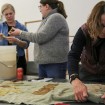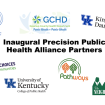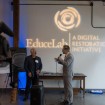Sanders-Brown researchers receive $20.5 million from National Institute on Aging
A team of researchers at the University of Kentucky’s Sanders-Brown Center on Aging (SBCoA) has been awarded a $20.5 million grant from the National Institute on Aging (NIA) of the National Institutes of Health (NIH).
The P01 award exemplifies team science, helping to support about 35 researchers across six different labs who will be working on four main projects, all with a common theme.
“We are a highly collaborative crew at Sanders-Brown, so we work together all the time anyway. A project like this is natural for us,” said P01 leader Chris Norris, Ph.D., professor in the UK College of Medicine’s Department of Pharmacology and Nutritional Sciences, and an associate director at SBCoA. “We are a group of researchers that are all trying to beat Alzheimer’s disease and related dementias.”
The large project is named Strategies for Targeting Astrocyte Reactivity in Alzheimer’s Disease and Related Dementias (STAR-ADRD). Norris says the acronym they came up with serves a double meaning as astrocytes — the focus of their project — are star-shaped cells.
Alzheimer’s disease and other forms of dementia are diseases caused by various pathologies. With this grant the research team plans to study the role of astrocytes in these disorders.
“Astrocytes are, in some ways, a forgotten cell in neurodegenerative diseases,” said Norris. “For many years they have been thought of as support cells for things like neurons. Neurons communicate extensively with one another to form memories that neuroscientists study. Neurons eventually die with the progression of Alzheimer’s and related dementias.”
Norris says astrocytes have many branches that wrap around blood vessels in the brain. These branches also wrap around many of the connections between neurons. Because of this arrangement, astrocytes are well-positioned to help deliver energy, nutrients and oxygen from blood to neurons.
“The reason we are so interested in astrocytes is because they show very obvious changes with neurodegenerative diseases like Alzheimer’s disease, where blood flow and communication between neurons is disrupted.”
When Alzheimer’s disease was first described, Norris says the pathology shown included reactive astrocytes. He says these cells tended to cluster around areas where there was pathology, like amyloid deposits in the brain — a hallmark of Alzheimer’s disease.
“So we have known about reactive astrocytes for more than a century, but we don’t really know what these cells do,” said Norris. “Most of the time when people study reactive astrocytes, they will label them in postmortem tissue especially around plaques, or around sclerotic blood vessels, or things like that. But we really don’t know what these cells are doing there. Are they responding to that damage? Are they driving that damage? We need to study them for their function or dysfunction and that is a primary aim of our new grant.”
The four separate projects making up the overall venture are being led by worldwide leaders in their respective fields. Donna Wilcock, Ph.D., will lead her lab in studying astrocyte connections that go around blood vessels; Pete Nelson, M.D., Ph.D., is leading a project studying a potassium channel that acts as a metabolic sensor in astrocytes; and Olivier Thibault, Ph.D., and his lab will look at how astrocytic insulin receptors help to control metabolism, blood flow and calcium homeostasis. Norris is directing a project on astrocytes and the uptake of glutamate, an excitatory neurotransmitter. Pradoldej Sompol, Ph.D., Yang Jiang, Ph.D., and Yuriko Katsumata, Ph.D., each direct critical service cores that support the four research projects.
“There is a huge emphasis by the NIH and the NIA to fight Alzheimer’s disease and related dementias,” said Norris. Congress has allocated a lot of money to combat the disease, so people are really interested right now. This is kind of the health care crisis of our generation."
There currently is not a cure for Alzheimer’s disease, and Norris says treatment options that have been FDA approved are lacking.
“Present treatments are not exactly good at reversing dementia or preventing it. They are having kind of mild effects in individuals. So there is a lot of room out there to look for other potential drug targets,” Norris said.
Norris says astrocytes are an appealing cell to study for this therapeutic potential as their actual function and contribution to pathology have been taken for granted for decades.
“If we can figure out what reactive astrocytes are doing in terms of pathology, then we can perhaps develop treatments to target those pathways and hopefully alleviate pathology,” he said.
SBCoA is uniquely situated for a project like this. The center is world-renowned for its brain bank as well as its team of researchers and research volunteers.
“They have gone above and beyond to participate in our studies and donate brain tissues and other nervous system tissues to help us figure out what causes dementia,” said Norris. “All of the studies that we do in animal models, we have parallel studies on human brain or on human tissue samples from our brain and biofluids bank. So, we can look at Alzheimer’s pathology and cerebrovascular pathology and then investigate how astrocyte signaling differs across these different disease states. Then we can go into the animal models and target these astrocyte pathways to see if brain function is improved or not.”
Norris says the whole purpose of P01 grants are to fund large, multi-lab projects built around a theme. The total product is then supposed to be greater than the sum of its parts. With teamwork and collaboration already at the forefront for each of the researchers involved, this is a project they are all ecstatic to be a part of and are very optimistic for its future.
“This grant is very opportune. It really comes at the right time. We are all very well positioned to target astrocytes and figure out what they’re doing in brain pathology and dementia. Everyone on this team is just incredible,” said Norris.
Research reported in this publication was supported by the National Institute on Aging of the National Institutes of Health under Award Number P01AG078116. The content is solely the responsibility of the authors and does not necessarily represent the official views of the National Institutes of Health.


